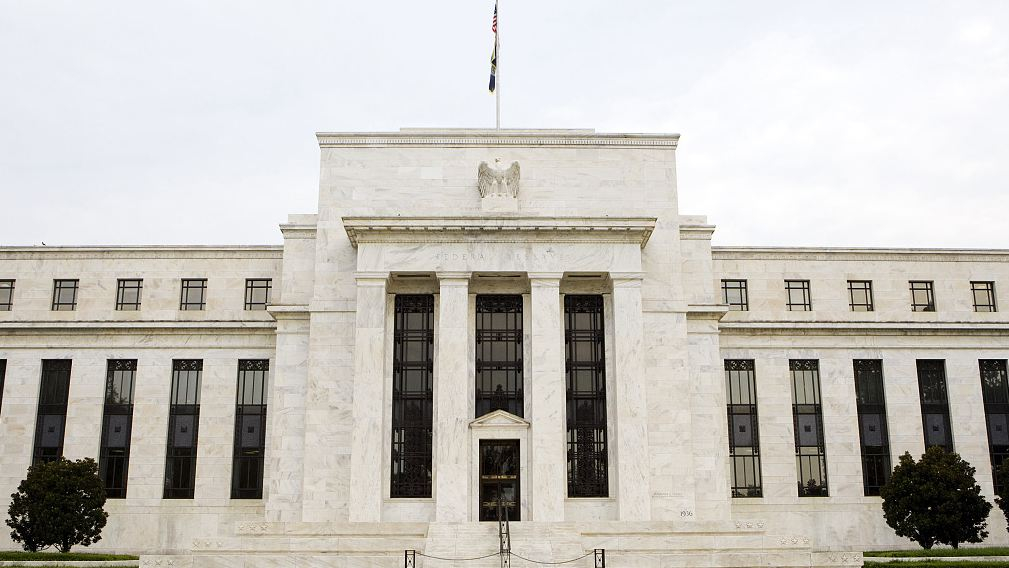
Editor's Note: Jimmy Zhu is chief strategist at Fullerton Research. The article reflects the author's opinion, and not necessarily the views of CGTN.
The meeting minutes from the Federal Open Market Committee (FOMC) released overnight signaled that the Fed could be preparing for another economic slowdown in 2020.
The reasons that Fed decided to hold the rate for now
The meeting minutes for the month of October shows the committees agreed to hold the policy rates for some time, yet it stressed the risks to the U.S. economy is increasing. This is confusing for some investors, as some of the market participants may have assumed that the Fed is either clueless on growth outlook, or the views among the committee members splitting. U.S. stocks declined after the release of the FOMC minutes, and safe-haven assets like U.S. Treasuries, Japanese yen rose.
There are reasons for the Fed to make some comments. First, it said "in particular, risks to the outlook associated with global economic growth and international trade were still seen as significant." The Fed is trying to convey the messages to the market that the central bank won't be able to solve some of the key risks threatening the global economy, like trade tension between the U.S. and China.
Second, the Fed's call to pause the rate cut is for saving "more bullets," instead of indicating that the U.S. economy is improving. Now the Fed's policy rate is 75 bps below the level at beginning of the year. There is some consensus that global economy is more challenging in 2020, the Fed must keep some rooms for the upcoming monetary easing. At the same time, the FOMC minutes also mentioned that monetary policy sometimes could take one year to show its impact on the real economy, so the Fed also needs some time to access the three cuts in previous quarter.

U.S. 3-month/Treasury yield. /Source: Bloomberg
U.S. 3-month/Treasury yield. /Source: Bloomberg
The Fed won't be able to hold for long as yield curve may get flattening again
Curve inversion in U.S. Treasury yield is one of the main reasons behind the Fed's cut in the third quarter, and the curve shows the signs it would flatten or invert again in near future. There are mainly two reasons below:
1) Traders start buying those safe-haven assets again such as those long-tenor U.S. Treasuries. The U.S. 10-year Treasury yield has dropped over 25 bps to 1.73 percent in past two weeks. Investors are ware of that regardless the progress of U.S.-China trade talks, global growth slowing down is intact.
The latest reading on JP Morgan global manufacturing PMI stood at 49.8, a reading below 50 shows that global manufacturing activities are still in the contraction territory. For now, there is no major economy around the world shows sign of recovery in its manufacturing sector, and that means the contraction in global manufacturing activities will continue for some time. The chart below shows that U.S. Treasury curve has a quite high correlation with the JP Morgan global manufacturing PMI. Hence, the Treasury curve is likely to stay flattening for now, and the Fed may step in to ease again if any inversion to re-emerge.

U.S. 3-month/10-year yield. /Source: Bloomberg
U.S. 3-month/10-year yield. /Source: Bloomberg
2) Even as the Fed decides not to cut the rate in the near future, the European Central Bank (ECB) may not follow suit this time. Christine Lagarde, the new ECB chief, has pledged to implement all kind of policies to support the growth in the bloc. Recent Euro Zone manufacturing PMI stood at 45.9, and its CPI growth slowed to 0.7 percent, well below the ECB's two percent target. These key economic indicators prompt the ECB to take action again.
Any dovish ECB's move is likely to drive the Germany bonds yield lower, and that would pressure the U.S. Treasuries' curve as well. Chart below shows that U.S. 3-month/10-year bond yield spread has been moving in tandem with the Germany 10-year bond yield. Such correlation suggests the ECB's monetary policy would flatten the U.S. yield curve, which is likely to prompt the Fed's action as well.

U.S. 10-year government bond. /Source: Bloomberg
U.S. 10-year government bond. /Source: Bloomberg
Another separate chart above shows that Germany and U.S. 10-year government bond yield have been also moving in the same direction in past five years.